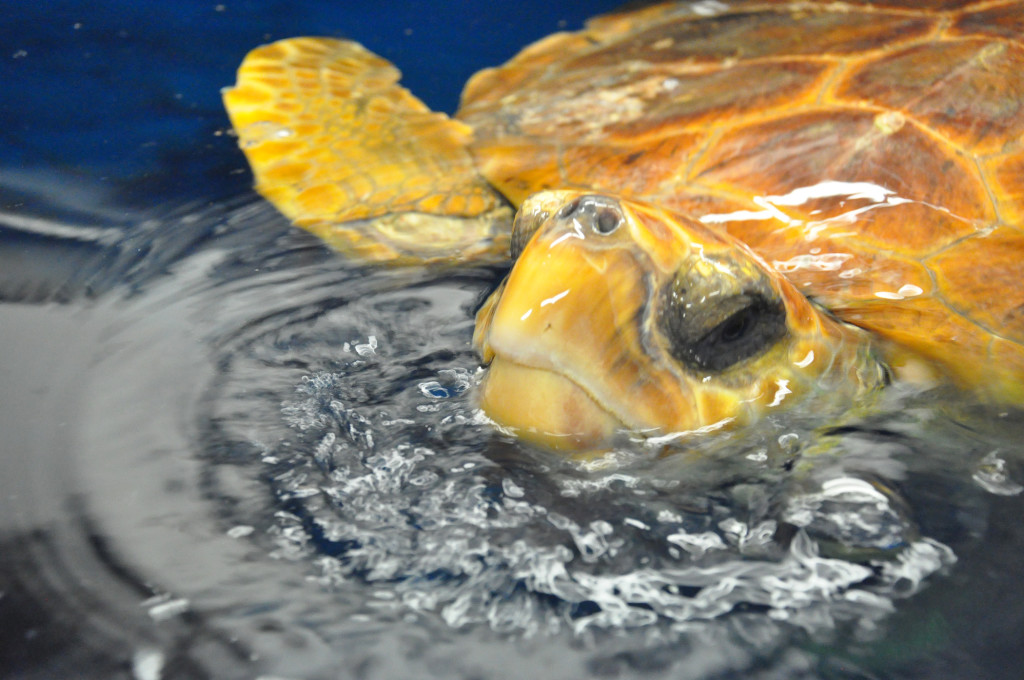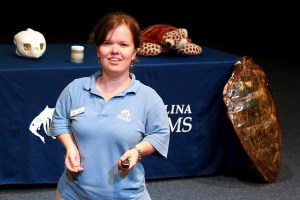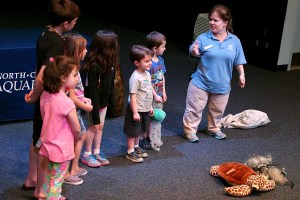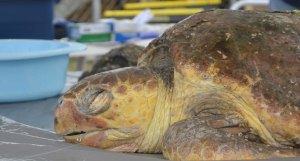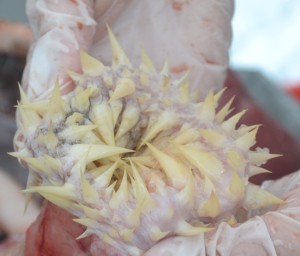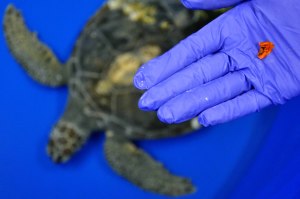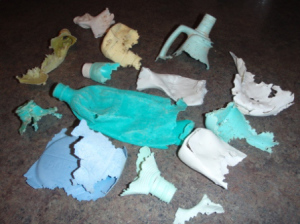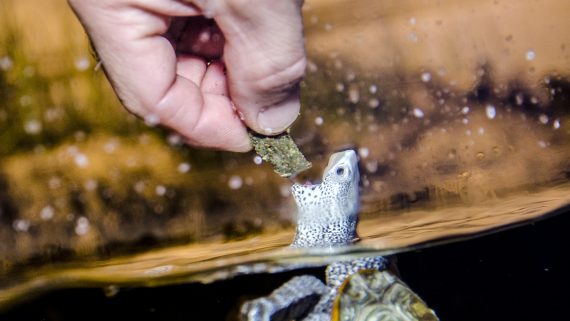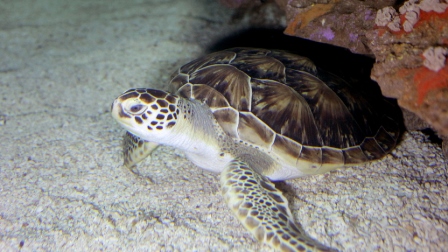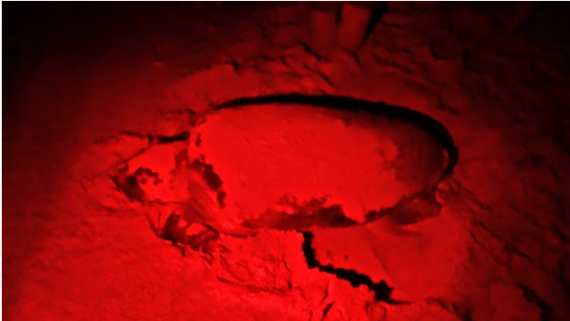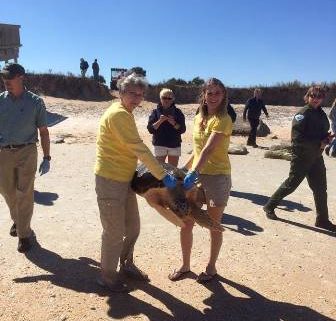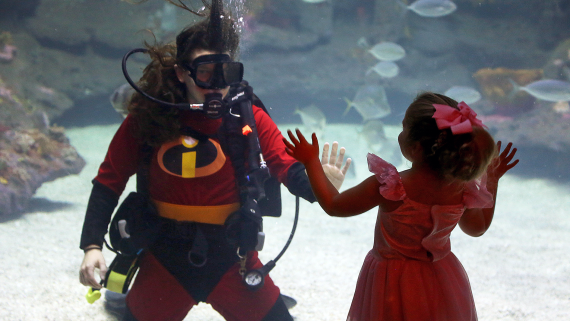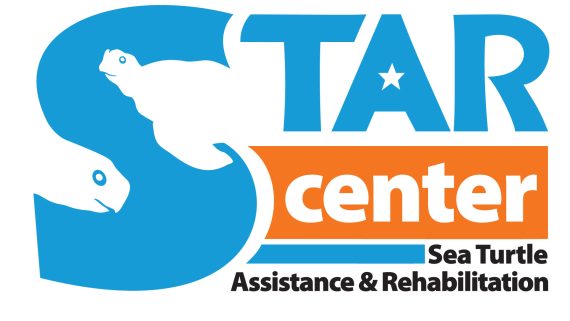Loggerhead Lunch
Hello all Sea Turtle lovers! My name is Aly Mack and I’m an educator at the North Carolina Aquarium at Fort Fisher.
I’ve always had a love for animals and wanted my career to be about helping them. Therefore, I decided to go to University of North Carolina at Wilmington (UNCW) and in my spare time I volunteered in the education department at NCAFF. I graduated from UNCW in 2011 with a Psychology degree, hoping to become a dolphin trainer. However, through my internship at a dolphin facility I realized that animal training was not my calling. As much as I loved taking care of dolphins, I loved talking to people about them more. After another internship, focusing on education, I applied and was hired for an educator position at the Aquarium My favorite program to teach is called Loggerhead Lunch, which focuses on general facts about sea turtles, what they eat and the threats to them.
Many of the threats to sea turtles occur because humans are unaware of how easily their actions impact sea turtles. The main activity during the program is having volunteers pick objects out of a large bag, and with the audience’s help, decide if the object is a “good” or “bad” thing for a sea turtle to eat. At the Aquarium, we collectively call all the “bad” things in the bag marine debris.
Marine debris comes in many forms. However there are ways that we can make sure that marine debris are almost non-existent. Below are a list of marine debris used in the program, the impact on sea turtles and what we can do to help.
Tangled fishing line:
- Problem: Cutting fishing gear (lines and nets) or leaving it for extended periods of time in the ocean causes gear to become tangled around other trash. Sea turtles may also swim into these areas looking for food and get caught in the fishing line/net. This can cause them to carry around the debris for a long time, altering the way they grow or swim (if the fishing line is around their body).
- Solution: Do not cut your line unless absolutely necessary. Instead, recycle your line by placing it in a monofilament recycling station. You can use biodegradable fishing line which takes a shorter amount of time to break down in the water. Also, be a responsible fisherman by being mindful of how long your nets are in the water.
Plastic Bags:
- Problem: Plastic bags find their way into the ocean, whether they blow away from us while we visit the beach, or from landfills. Unfortunately they are found in sea turtles’ stomachs too. When we see a plastic bag, we know it’s not food. But sea turtles brains are about the size of our thumb, They mistake the plastic bag for something they love to eat- jellyfish. Because of their backward facing papillae (specialized taste buds ) in their mouth it is easy for sea turtles to swallow plastic bags. However, when a plastic bag gets to a sea turtle’s stomach, it causes the turtle to feel full and eventually starve. In some cases, scientists have found more plastic bags in sea turtles than actual food.
- Solution: Instead of using plastic bags, use paper bags or reusable bags. Saying no to plastic bags when you go shopping will help keep sea turtles and other marine animals stay safe
Balloons:
- Problem: Balloons are used in celebrations and memorials. However, when they are released into the sky those flying balloons have tendency to pop near an animal habitat, ocean or land. What we do inland affects habitats near the ocean because balloons can float very far distances. A balloon in the ocean threatens sea turtles the same way as plastic bags.
- Solution: Be aware where you dispose of balloons. Make sure they are not able to blow away and impact animals. If you are looking for other options to use for memorials think about planting a tree, lighting luminaries, pinwheels or bubbles. Instead of giving balloons to kids at birthday parties, give them ribbon dancers, which are much more fun and more environmentally friendly.
Plastic bottles:
- Problem: When we litter, animals mistake our trash for their food. We don’t like living with trash around our house such as plastic bottles, cans, candy wrappers, cigarette butts, etc..We shouldn’t make other animal species live with the same trash.
- Solution: Properly dispose of trash and recycle what you can. The earth is not one big trash can. Keep it clean and beautiful for all animal species and for our future generations.
These are all easy things you can do to help protect sea turtles and other animals out in the ocean. Below, tell us what steps you’re taking to keep plastics out of our ocean! For more tips, visit Womble’s Tale and our Recycled Plastics Pinterest Board. If you are following the growth of our loggerhead hatchlings, Turtle A weighs 733 gram and is 17.1 cm long. Turtle B weighs 828 grams and 17.5 cm long. For more information on what to do with those numbers, please check out our lesson: Hatchling to Yearling.


